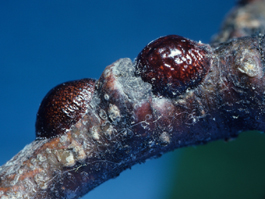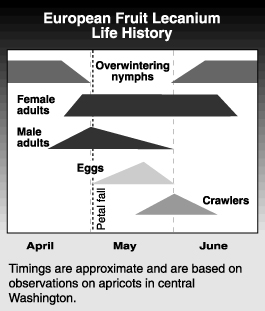by Helmut Riedl, originally published 1993
Parthenolecanium corni (Bouché) (Homoptera: Coccidae)
European fruit lecanium, also known as brown apricot scale, is a common pest of tree fruits in the Pacific Northwest. The most common damage is russet and sooty fungus growth on the fruit caused by honeydew produced by the nymphs. It can also impair tree growth and even kill limbs.
Hosts
European fruit lecanium most often attacks stone fruits but may damage pome fruits and many other broad-leaved plants. It is a common pest of landscape plants as well as commercial fruit trees.
Life stages

Egg
The egg is oval and pearly white.
Nymph
The newly hatched nymph, or crawler, is oval, flat and salmon colored. It later develops a hardened shell for protection.
Adult
The adult male has wings held flat over its abdomen. It emerges from under the protective covering after a short resting period or pseudo pupal stage. It can fly and crawl. The female cannot move but remains under its shell where it deposit eggs. The mature female is the most conspicuous stage of this pest. The protective scale is hemispherical and chestnut brown. It measures between 1/8 and 1/4 inch (3 to 5 mm) in diameter. Empty shells often remain attached to the tree bark throughout summer and fall. A few may still be found a full year after the female has died.
Life history
 Overwintering nymphs mature into adults in April. After emerging from their coverings, males seek females for mating and die within a few days. Females remain under their shells where they deposit eggs during May. Eggs loosely fill the mother’s shell as she shrinks away during her egg-laying period.
Overwintering nymphs mature into adults in April. After emerging from their coverings, males seek females for mating and die within a few days. Females remain under their shells where they deposit eggs during May. Eggs loosely fill the mother’s shell as she shrinks away during her egg-laying period.
Between mid-May and early June, eggs hatch into crawlers which are exposed and able to move about. After finding a suitable feeding site, usually on the undersides of leaves, crawlers settle and feed until early fall. Before leaf drop, the nymphs migrate back to current year shoots and settle again, this time developing a hardened shell for protection. They overwinter there and begin to feed and grow again during the following spring.
There is a single generation of European fruit lecanium per year. Crawlers can move from tree to tree on other insects or birds’ feet or may be blown by the wind. People thinning or doing other tasks involving close contact with trees can also move crawlers between trees as they work.
Damage
European fruit lecanium damages fruit trees in two ways. As with most sucking pests, it can devitalize the tree, resulting in reduced growth, poor fruit size and, in severe cases, dead limbs. The most common damage is due to honeydew, which is excreted by feeding nymphs and drips onto fruit and foliage. On fruit, honeydew leads to russet and is a medium for growth of sooty mold. Most honeydew is produced in late spring when nymphs are large and feed heavily on 1-year-old wood.
Monitoring
Large nymphs are easy to see during the dormant season on last year’s growth. Once an infestation is detected, female development and egg hatch should be monitored by turning over the protective scales and examining the contents under magnification. Other indications of an infestation include sticky fruit and foliage, coarse russet on fruit, and sticky plants and ground under trees. When you notice these conditions, look for infestations on the bark.
Biological control
Natural enemies such as ladybird beetles, lacewings and predaceous bugs feed on crawlers as they emerge from under their mothers’ scales and crawl to leaves to feed.
Management
Natural enemies normally keep European fruit lecanium at below damaging densities, but when pesticide sprays or other factors disrupt natural control, populations of this pest can reach damaging levels.
It is possible to control this pest with delayed-dormant sprays of oil and an organophosphate insecticide. Chemical sprays to control this pest are most effective when timed for the crawler stage. Time treatments by checking for crawlers hatching under female scales. Wait until most eggs have hatched or until a few crawlers have settled on leaves before applying the first spray.
If egg hatch is prolonged, a second application may be necessary for good control. Because crawlers are active in late spring when there is lots of foliage on the trees, dilute sprays are more effective than concentrate applications.
